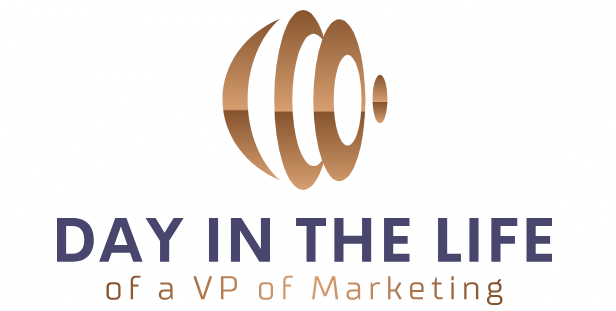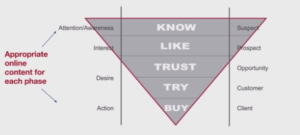If we do this content right and we put it on the right platforms in the right way, we establish our brand and relieve our sales teams to find additional stakeholders to further target account-based selling.
The amount of content that is consumed every day is growing by leaps and bounds. It seems like there’s no end to it. So people want content and they just want to consume content in their way on their schedule when they’re ready to do it. But the great thing is we have new tools to reach them the way that they want to be reached and in ways that are very, very economical. And if we do this content right and we put it on the right platforms in the right way, we establish our brand, our expertise and authority when that content is consumed. This makes selling easier when it is time to actually sell, to actually get something to convert to an opportunity and pipeline. When we have that foundation established, our brand, our expertise, our authority, our credibility selling is much much much easier, and we do this with content marketing and retargeting (among other ways discussed in other posts on this site). Content marketing and retargeting are two necessary tools.

Neither of these concepts are brand-new. Retargeting has come in the mainstream in the last couple of years. Content marketing, at least five years before that really evangelized by many leading marketers (HubSpot comes to mind) when they started their business, but it’s the culmination both retargeting and content marketing and the ease of the execution of the two in creating marketing and sales models that work for the business, that really has come together, just the last year or so.
Content Marketing and Retargeting Together is a Power Punch to your Digital Marketing
Content marketing and retargeting means that we’re going to use online content to get affordable, large targeted distribution, to the audiences that we want to reach. (Think way back before when you use to do this in the older sales system with direct mail pieces, cold calling – both of those things still work by the way, but they are much more expensive, both from a financial perspective and time invested to execute and the reality is that many of us just don’t have the budgets to do those things at the scale that we want to.) So online content marketing gives us that scalability, gives us the targeting, but it’s very affordable. Now retargeting allows us to keep in touch with those that are interested with the people that raise their hands and say, yeah, I’m interested in this message that you have, retargeting allows us to keep in touch with them, and progressively move them through a funnel and that’s what’s key, progressively move them through a funnel.
A Systematic Way to Approach Retargeting and Content Marketing
I want to be really clear. I am not saying just put content out into the ether, and hope that deals come to you. Hopefully you know me better by now, that I don’t play business that way. We approach business and sales as a very systematic process to generate revenue. Systematic and measurable and that has not changed. We are going to use content marketing and retargeting to move them through our funnel, progressively proactively move them through our funnel in a very measurable, systematic and automated way and that’s what’s really key about this model is that we can do this all largely just on an automated basis so that we are constantly filling the top of our funnel and moving prospects through the first handful stages of our formal without the expense of manual effort.
We are now going to use content throughout each of these stages much more aggressively and we’re going to use remarketing to drive people through our sales process. What makes this all work in a highly leveraged, highly automated and targeted way for to put together content that effectively reaches out to our prospects and converts them into opportunities in a very systematic way by taking advantage of the power of the online distribution content and remarketing.
How Much Content is Enough?
So this does not mean that you have to become the next HubSpot or Intel and be cranking out content all the time. It will not require you to be constantly cranking out content, that was actually the challenge of trying to move toward an internal goal to do more content marketing about a year ago. It was like being on a treadmill of cranking out content all the time and it’s not really getting me anywhere in terms of measurable progress through a sales funnel. That’s changed in the last six months, and that’s what this series of posts are about. So you’ve got to use that content to let prospects discover your business and pull themselves through your funnel but again, this isn’t passive, you need to have a deliberate model to help them by strategically using that content at, the right time, at the right place.
The Content Marketing Framework
Okay so this is a diagram of a sales funnel and you’ll see all kinds of different versions of these. This just happens to be one that I like. I like to identify and give names to the different stages of people in those sales funnel, such as; suspects, prospects, opportunities, customers. Suspect are people that we believe just based on their titles and demographics and psychographics and location and things like that that they could potentially be a prospect of ours. A prospect is somebody who as actually raised their hands and said yes, I’m interested in what’s going on here, an opportunity somebody who actually has a time frame and a budget, a customer. Somebody who has spent at least a dollar with us and a client. Somebody who has an ongoing relationship with us and then on the left-hand side you have these phases, essentially the psychology of the people in your funnel. Attention and awareness, interest, desire and action. AIDA, a very classic marketing acronym AIDA attention, interest, desire, action.
So our job now is to create appropriate online content for each phase of this funnel. And each phase, specifically of the AIDA steps there, but we’re going to simplify even more, we’re just going to focus that down, just to three steps to the buyer journey. Awareness, Research, Consideration (Evaluation) is what we’ll cover in this model of buyer journey phases. I want to stress that so much that you have got to drink the Kool-Aid on this, or you really miss being left behind. Those that take advantage of this model win and you can look in every industry and you will find companies that get this and are doing it well and are crushing the competition and then you will find the majority of the companies that are sitting around watching them on wondering what happened. You don’t want to be one of those businesses. Learn how to do this right and you will dominate in your market. You will generate awareness, way beyond what your competition is able to, you will have dramatically more expertise perceived expertise and authority. You will have a dramatically lower cost sales model because you will be filling up your pipeline every day and moving people moving through that pipeline every day, using a largely automated approach that is online and therefore very inexpensive and you will be transitioning from a model of sales by pushing to me. I mean we’re making a 100 cold calls a day to people who didn’t want to hear from us to a model of sales by pulling, where we’re effectively putting our lures out there letting our prospects by and employ them into our funnel. This is the new way of selling and this is how you win in the marketplace today and going forward.
Originally posted 2015-11-01 01:58:05.



